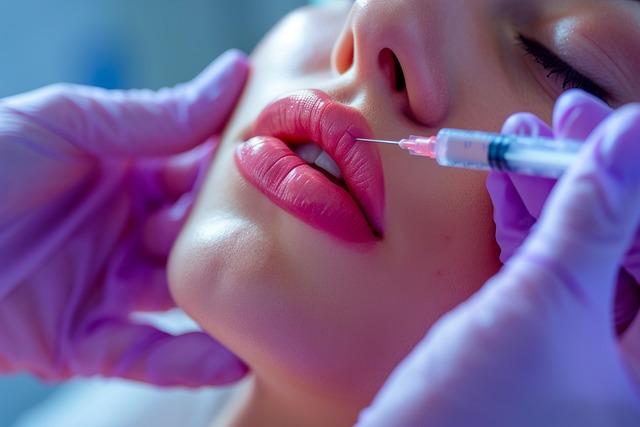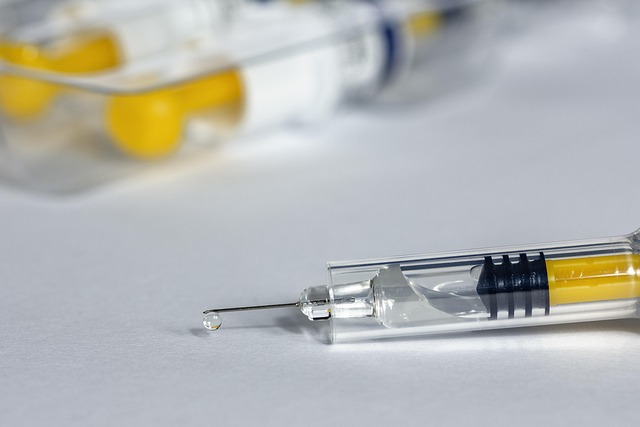Botox injections are a popular, non-surgical solution for smoothing forehead wrinkles caused by muscle contractions. Derived from Botulinum Toxin, these injections temporarily paralyze muscles, reducing dynamic facial lines and improving skin appearance. Administered by trained professionals, Botox offers natural results with minimal downtime, making it an appealing choice for individuals seeking temporary yet effective wrinkle reduction. While generally safe, potential side effects include mild bruising and swelling, highlighting the importance of choosing a qualified provider. Proper post-treatment care and regular follow-ups ensure optimal results, while repeated injections may be needed to maintain smoothness over time.
“Uncover the secrets to a smoother forehead with our comprehensive guide on Botox injections. Forehead lines, caused by muscle activity and aging, can now be effectively treated with this popular cosmetic procedure. We demystify Botox, explaining its role in relaxing muscles and reducing dynamic wrinkles. From understanding the causes of forehead lines to exploring the benefits and potential risks, this article offers a detailed look at Botox injections as a solution for achieving a youthful appearance. Discover the step-by-step process, essential considerations when choosing a doctor, and post-treatment care.”
Understanding Forehead Lines and Their Causes

Forehead lines, often referred to as frown lines or expression lines, are a common concern for many individuals as they can give the appearance of age and worry. These wrinkles form due to repeated muscle contractions, particularly when frowning or making other facial expressions. Over time, these contractions lead to the breakdown of collagen and elastin fibres in the skin, resulting in noticeable creases and lines on the forehead.
Botox injections have emerged as a popular and effective solution for treating forehead lines. Botox is a neurotoxin that relaxes muscles by blocking nerve signals, which can significantly reduce the appearance of wrinkles. When injected into specific muscle groups responsible for causing frown lines, Botox can prevent these muscles from contracting, thereby smoothing out the skin’s surface and minimizing the depth of wrinkles.
What is Botox? A Simple Explanation

Botox, short for Botulinum Toxin, is a natural protein produced by bacteria called Clostridium botulinum. When used therapeutically, it’s injected into specific muscles to temporarily paralyze or relax them. This action smooths out wrinkles and fine lines, offering a non-surgical alternative to cosmetic procedures. In the context of forehead lines, Botox injections can significantly reduce the appearance of frown lines and horizontal creases that often develop over time due to repeated facial expressions.
As a popular aesthetic treatment, Botox injections have gained wide acceptance for their ability to enhance natural beauty while providing a youthful glow. It’s important to note that these treatments are administered by trained professionals who tailor the amount and placement of injections to meet individual needs, ensuring optimal results with minimal downtime.
The Mechanism of Action: How Botox Works

Botox injections work by temporarily paralyzing specific muscles responsible for causing facial lines and wrinkles, particularly those on the forehead. It’s a neurotoxin that blocks nerve signals to the muscles, preventing them from contracting and resulting in reduced appearance of dynamic lines like frown lines or crow’s feet.
When injected into the target areas, Botox binds to vesicles within the muscle cells, inhibiting the release of acetylcholine, a neurotransmitter involved in muscle contraction. This disruption prevents the overactive muscles from pulling on the skin, thereby smoothing out fine lines and wrinkles for a more youthful appearance. The effects typically last between 3-6 months, after which touch-up injections may be needed to maintain the results.
Benefits of Botox Injections for Forehead Lines

Botox injections have emerged as a popular and effective non-surgical treatment for reducing forehead lines and wrinkles. This procedure involves the injection of botulinum toxin, which temporarily paralyses the muscles responsible for causing dynamic facial lines. By relaxing these muscles, Botox can significantly decrease the appearance of expression lines on the forehead, between the eyebrows, and along the temples—areas that are particularly prone to creasing over time due to frowning or squinting.
One of the key benefits of Botox injections is their ability to provide a natural-looking result. Unlike surgical options, which can lead to downtime and potential scarring, Botox offers a quick, minimally invasive approach. The treatment is usually well-tolerated, with only temporary discomfort during injection, and results can last for several months, allowing individuals to enjoy smoother, rejuvenated skin without the need for frequent treatments. This makes it an appealing choice for those seeking a long-lasting yet non-permanent solution to forehead lines.
The Procedure: Step-by-Step Guide to Botox Treatment

The procedure for Botox injections on the forehead begins with a consultation where a qualified practitioner assesses your skin and determines the best treatment plan. During the actual treatment, a small amount of Botox serum is injected into targeted areas along the forehead using fine needles. The injections work by temporarily paralyzing muscles, reducing their ability to contract and thus smoothing out lines and wrinkles.
After the injections, there may be mild redness or swelling in the treated area, but these typically subside within a few hours. Patients can return to their regular activities immediately, though it’s recommended to avoid strenuous exercise or excessive sun exposure for a day or two. Multiple sessions may be necessary for optimal results, spaced several months apart, as Botox’s effects wear off over time.
Choosing the Right Doctor for Your Botox Injection

When considering Botox injections for forehead lines, choosing the right doctor is paramount. It’s not merely about finding a practitioner who offers the treatment; it’s equally important to ensure they have expertise and experience in facial aesthetic procedures, specifically Botox. Look for board-certified dermatologists or plastic surgeons with a proven track record of successful botox treatments. Reputable professionals will take the time to understand your concerns, assess your skin, and discuss the expected outcomes, risks, and benefits. They’ll also use sterile techniques and high-quality products to guarantee safety and efficacy.
Beyond qualifications, consider the consultation process. A good doctor will answer all your questions thoroughly, address any fears, and provide realistic expectations. They should offer personalized recommendations tailored to your specific needs rather than pushing a one-size-fits-all approach. Reviews from previous patients can also be valuable in assessing a doctor’s bedside manner and treatment results.
Potential Side Effects and Risks to Be Aware Of

While botox injections are generally considered safe and effective for treating forehead lines, it’s crucial to be aware of potential side effects and risks. Common temporary side effects include mild bruising, swelling, or discomfort at the injection site. In some cases, patients may experience headaches, fatigue, or muscle weakness temporarily.
Less common but more serious potential risks associated with botox injections include allergic reactions, difficulty breathing, or an abnormality in speech. It’s essential to choose a qualified and experienced provider to minimize these risks. Always discuss any concerns or medical history with your doctor before undergoing the procedure.
Maintenance and Follow-up Care After Botox Treatment

After your Botox injections for forehead lines, proper maintenance and follow-up care are essential to maximize results and ensure a smooth recovery. It’s crucial to avoid strenuous activities and excessive sun exposure for the first few days post-treatment to prevent bruising or irritation. Staying hydrated and applying gentle, non-irritating skincare products can aid in healing and maintain the treated area’s health.
During follow-up appointments, your healthcare provider will assess the treatment’s effectiveness and address any concerns. They may recommend touch-up injections or offer alternative strategies for ongoing management based on individual needs. Following their guidance diligently will help preserve the results and ensure long-lasting improvement in the appearance of forehead lines.
